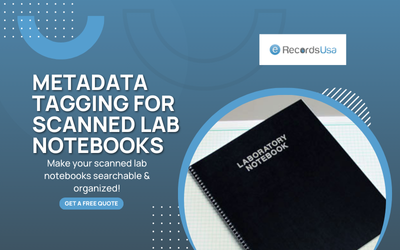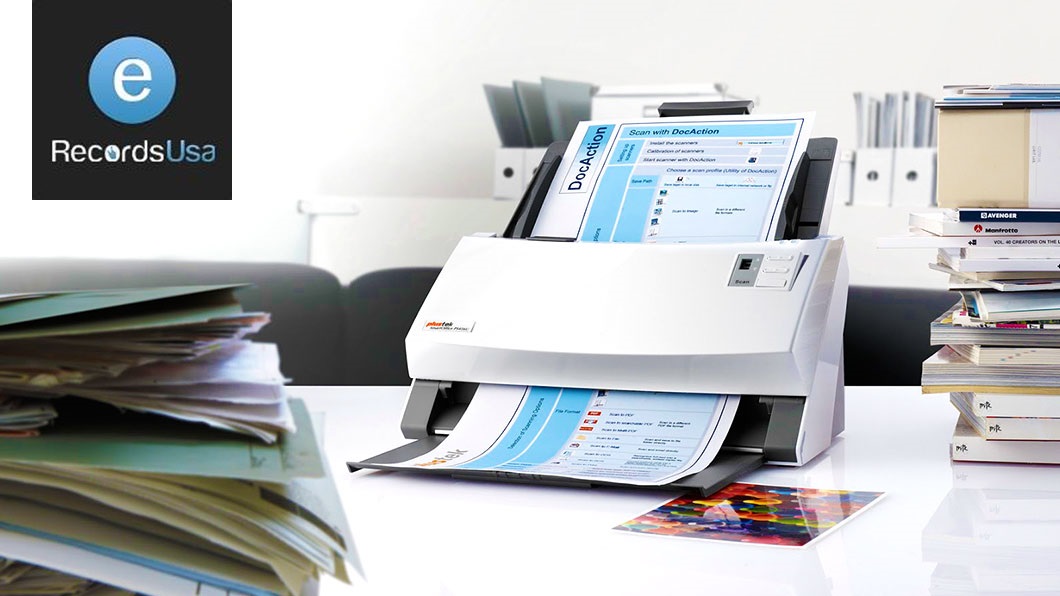Have you ever struggled to find a specific experiment or research entry in a scanned lab notebook? Without a structured way to categorize and retrieve information, even digitized notebooks can become disorganized and unsearchable.
Metadata tagging is the solution to this problem. By assigning descriptive labels, timestamps, and classifications to scanned lab notebooks, metadata transforms raw digital files into structured, searchable records. This approach ensures that researchers, laboratory managers, and archivists can quickly retrieve critical data, collaborate efficiently, and maintain compliance with industry regulations.
So, without further ado, let’s start simplifying lab notebook digitization!
Why Metadata Tagging Matters for Scanned Lab Notebooks?
- Instant Searchability – Locate specific pages, experiments, or chemicals with a simple keyword search.
- Enhanced Collaboration – Researchers can tag, categorize, and cross-reference findings effortlessly.
- Regulatory Compliance – Aligns with standards such as FDA 21 CFR Part 11, GLP (Good Laboratory Practices), and GDPR.
- Long-Term Data Preservation – Protects scientific records, ensuring they remain accessible for future research, patents, and historical reference.
What You’ll Learn in This Guide
This guide will cover:
- What metadata tagging is and how it works
- Why it’s essential for organizing scanned lab notebooks
- How it supports compliance with industry regulations
- Best practices for effective metadata tagging
- Real-world use cases in research and industry
🚀 If your lab is managing a growing archive of scanned notebooks, metadata tagging is the key to unlocking efficiency, organization, and compliance. Let’s explore how it works!
What Is Metadata Tagging?
Have You Ever Wondered How Digital Files Become Searchable? When you search for a file on your computer, a research paper in a database, or an old experiment in a scanned lab notebook, metadata is working behind the scenes. But what exactly is metadata tagging, and why is it crucial for organizing scanned lab notebooks?
Metadata is data about data—it provides information that describes and categorizes digital content. In the context of scanned lab notebooks, metadata tagging involves assigning structured information to each document, making it searchable, filterable, and easily retrievable.
🔍 Example: Instead of manually searching through hundreds of scanned lab pages, a metadata tag like “Experiment: DNA Sequencing, Date: 2023-06-15, Researcher: Dr. Smith” allows instant retrieval.
Types of Metadata for Scanned Lab Notebooks
Metadata is typically categorized into three main types:
| Type of Metadata | Purpose | Examples |
|---|---|---|
| 📑 Descriptive Metadata | – Provides key details about the content. – Helps users identify and locate documents. |
🔹 Title: “PCR Results – Sample A” 🔹 Author: Dr. Emily Carter 🔹 Keywords: DNA sequencing, PCR analysis |
| 📂 Structural Metadata | – Defines how scanned documents are organized and related. – Helps create a hierarchical structure for easy navigation. |
🔹 Notebook Table of Contents 🔹 Experiment Sections and Subsections 🔹 Page numbers and relationships between files |
| 🔐 Administrative Metadata | – Stores technical details and permissions related to the document. – Ensures data security, compliance, and version tracking. |
🔹 Creation Date: 2024-01-30 🔹 File Format: PDF, TIFF 🔹 Access Control: Restricted, Public, Internal |
Why Metadata Tagging is the Backbone of Digital Lab Organization?
Metadata transforms scanned lab notebooks from static files into dynamic, searchable databases. With proper tagging, researchers can:
- Quickly locate past experiments and results
- Ensure consistency in documentation for regulatory audits
- Enable automation for research analysis
🚀 Next, we’ll explore why metadata tagging is essential for lab efficiency, compliance, and large-scale research organization.
Why Is Metadata Tagging Crucial for Scanned Lab Notebooks?
How Do You Find One Experiment Among Thousands of Pages? Imagine searching for an experiment conducted three years ago in a scanned lab notebook archive with thousands of pages. Without metadata tagging, you’d have to manually sift through files, wasting hours. This inefficiency can slow down research, delay regulatory submissions, and increase the risk of data loss.
Metadata tagging solves this challenge by making scanned lab notebooks searchable, structured, and scalable. It enhances lab operations by enabling quick access, improved collaboration, and regulatory compliance.
1. Organizational Benefits: Bringing Order to Scanned Lab Notebooks
| Problem | Solution | Key Benefits | Example |
|---|---|---|---|
| Without metadata, scanned lab notebooks are just static PDFs or images, making it difficult to extract information. | Metadata tagging allows systematic organization using labels like experiment name, researcher, date, and project category. | ✅ Faster Retrieval: Locate specific experiments instantly. ✅ Standardized Documentation: Ensures consistency in research records. ✅ Better Knowledge Management: Links related studies for historical reference. |
A university research team working on gene editing can filter all CRISPR-related experiments by adding tags like:
🔹 Project: CRISPR Study |
2. Searchability: Turning Scanned Pages Into Searchable Data
| Problem | Solution | How Metadata Improves Searchability | Tech Tip |
|---|---|---|---|
| Most scanned lab notebooks lack keyword search functionality. | Metadata tagging converts handwritten or printed content into structured, searchable data. | ✅ Enables keyword-based searches: Locate specific terms like “pH measurement” or “cell culture experiment” instantly. ✅ Supports advanced filtering: Organize notebooks by researcher, date, or project type. ✅ Allows cross-referencing: Link related notebooks for comprehensive research tracking. |
Pair metadata tagging with OCR (Optical Character Recognition) to extract text from scanned notebooks and AI-based auto-tagging for even faster data retrieval. |
3. Scalability: Managing Large Volumes of Research Data
| Problem | Solution | Scalability Benefits | Example |
|---|---|---|---|
| As labs scale, the number of scanned notebooks grows exponentially, making manual searches impractical. | Metadata tagging helps laboratories efficiently organize thousands of documents while maintaining quick searchability. | ✅ Handles growing research archives: Ensures fast retrieval without performance slowdowns. ✅ Enables multi-location collaboration: Supports global research teams with standardized metadata. ✅ Supports AI automation: Enhances indexing and categorization for effortless searchability. |
A pharmaceutical company handling clinical trial notebooks uses metadata to tag all patient-related experiments, ensuring compliance with FDA regulations while making research easily accessible. |
Why Metadata Tagging Is a Game-Changer for Lab Efficiency?
- Eliminates hours of manual searching
- Facilitates research continuity and team collaboration
- Meets regulatory and audit requirements
- Scales seamlessly with lab growth
🚀 Next, we’ll explore how metadata tagging plays a critical role in research integrity, compliance, and audits.
The Role of Metadata Tagging in Research and Compliance
How Can You Prove the Integrity of Your Research? In the world of scientific research and laboratory work, documentation isn’t just about keeping records—it’s about proving credibility. Whether for patent filings, regulatory audits, or data verification, researchers must ensure their scanned lab notebooks are accurate, traceable, and compliant.
Metadata tagging plays a crucial role in maintaining research integrity, compliance, and accessibility. By embedding structured metadata in scanned lab notebooks, organizations can meet regulatory requirements, provide audit trails, and protect intellectual property.
1. Regulatory Compliance: Meeting Industry Standards
| Problem | Solution | Key Regulatory Frameworks | How Metadata Helps | Example |
|---|---|---|---|---|
| Regulatory bodies require proper documentation and traceability, yet many labs struggle to organize vast amounts of research data efficiently. | Metadata tagging helps labs comply with legal, ethical, and industry-specific regulations by ensuring well-structured, time-stamped, and verifiable records. | ✅ FDA 21 CFR Part 11: Requires secure digital record-keeping for electronic lab notebooks. ✅ Good Laboratory Practice (GLP): Ensures research documentation is complete, accurate, and retrievable. ✅ General Data Protection Regulation (GDPR): Protects sensitive data by enforcing metadata-based access controls. ✅ ISO 17025: Requires traceable lab records for accreditation in testing and calibration laboratories. |
✅ Adds time stamps and authorship details for transparency. ✅ Maintains version control for compliance audits. ✅ Protects research from falsification or unauthorized access. |
A pharmaceutical company conducting clinical trials must submit accurate lab records to regulatory authorities. Metadata tagging ensures every scanned notebook entry includes:
🔹 Experiment Date This not only speeds up the approval process but also minimizes the risk of compliance violations. |
2. Research Validation: Ensuring Data Authenticity
| Problem | Solution | Key Benefits for Research Validation | Example |
|---|---|---|---|
| How do researchers prove that their findings are based on authentic, untampered data? | Metadata provides a clear history of every research entry, preventing data loss, fraud, and duplication. | ✅ Ensures reproducibility: Provides detailed documentation. ✅ Links related experiments: Enables easy cross-referencing. ✅ Supports patent filings: Verifiable experiment records strengthen IP claims. |
A biotech company working on a new drug formulation must prove that its research was conducted before a competitor filed for a patent.
By using metadata timestamps and version tracking, the company provides concrete evidence of prior work, securing intellectual property rights. |
3. Audit Trails: Protecting Research Integrity
| Problem | Solution | How Metadata Creates Secure Audit Trails | Example |
|---|---|---|---|
| Without an audit trail, it’s difficult to prove when and how research was conducted. | Metadata tagging automatically records changes, creating a clear, immutable audit trail for compliance purposes. | ✅ Tracks file access and modifications: Identifies users who accessed or changed a document. ✅ Logs time-stamped entries: Ensures transparency and accountability. ✅ Prevents unauthorized alterations: Ensures records cannot be modified without leaving a trace. |
A university research lab conducting government-funded studies is required to submit detailed reports every quarter. By using metadata, they:
✅ Provide clear documentation for funding agencies. |
Why Metadata Tagging Is Critical for Research Compliance?
- Protects intellectual property and research authenticity
- Ensures labs meet regulatory and funding requirements
- Prevents legal and ethical violations
- Creates transparent, immutable audit trails
🚀 Next, we’ll explore the best practices for implementing metadata tagging effectively in scanned lab notebooks.
Best Practices for Metadata Tagging in Scanned Lab Notebooks
How Can You Ensure Metadata is Accurate and Useful? Metadata tagging is only as effective as the consistency and accuracy of its implementation. Poorly structured metadata can lead to search inefficiencies, compliance risks, and data loss. To maximize the value of metadata tagging in scanned lab notebooks, laboratories must adopt standardized, automated, and validated tagging practices.
1. Standardization: Creating a Uniform Metadata Framework
| Problem | Solution | Key Standardization Practices | Example |
|---|---|---|---|
| Inconsistent metadata formats can cause confusion, making it difficult to search and retrieve data. | Establish a standardized metadata structure that aligns with industry best practices and regulatory requirements. | ✅ Use consistent naming conventions: Standardize experiment, researcher, and process names. ✅ Adopt recognized metadata standards: 🔹 Dublin Core: Widely used for research documentation. 🔹 MARC: (Machine-Readable Cataloging) Common in digital archiving. 🔹 ISO 19115: Metadata for geographic and scientific data. ✅ Define a controlled vocabulary: Ensures uniformity in tagging and improves searchability. |
A university lab uses metadata to tag scanned chemistry notebooks. Instead of inconsistent variations like:
❌ “pH study 2023” They implement a standard convention: ✅ Experiment Type: pH Analysis This uniformity allows for consistent searchability and categorization across all lab records. |
2. Automation: Using OCR for Metadata Extraction
| Problem | Solution | 🔹 AI-Powered Metadata Tagging Benefits | 📌 Recommended Tools | 🔍 Example |
|---|---|---|---|---|
| Manual metadata entry is prone to errors and consumes valuable research time. | Leverage Artificial Intelligence (AI) and Optical Character Recognition (OCR) tools to automate metadata tagging in scanned lab notebooks. | ✅ Automatic Metadata Extraction: Detects and extracts experiment titles, researcher names, and dates. ✅ OCR for Handwritten Text: Converts handwritten notes into searchable metadata. ✅ Intelligent Categorization: Organizes experiments based on predefined taxonomies. |
🔹 ABBYY FineReader: Extracts text and metadata from scanned PDFs. 🔹 Google Cloud Vision AI: Recognizes and tags handwritten notes. 🔹 ELN (Electronic Lab Notebook) Software: Automates metadata generation for research workflows. |
A biotech company scans thousands of lab notebooks for regulatory compliance. By integrating AI-powered metadata tagging, they:
✅ Reduce manual workload by 80% |
3. Validation: Ensuring Metadata Accuracy and Integrity
| Problem | Solution | Best Practices for Metadata Validation | Example |
|---|---|---|---|
| Inaccurate or missing metadata can cause search failures and compliance risks. | Regularly validate metadata for accuracy, completeness, and compliance. | ✅ Conduct periodic metadata audits: Detect errors or inconsistencies early. ✅ Implement approval workflows: Require review by lab managers or data specialists. ✅ Use metadata versioning: Track historical changes for better auditability. |
A pharmaceutical company conducting clinical trials enforces a quarterly metadata validation process. This ensures that all scanned lab notebooks have:
✅ Correct experiment tags This practice helps them avoid regulatory penalties and maintain high data integrity. |
Why Following Best Practices in Metadata Tagging is Essential?
- Standardization eliminates confusion and improves searchability.
- Automation reduces manual errors and speeds up tagging.
- Validation ensures compliance and protects research integrity.
🚀 Next, we’ll explore real-world examples of how metadata tagging transforms lab notebook organization.
How Metadata Tagging Transforms Lab Notebook Organization – Use Cases
How Do Different Industries Benefit from Metadata Tagging? Metadata tagging isn’t just a technical upgrade—it’s a game-changer for research institutions, pharmaceutical companies, and historical archives. By implementing structured metadata, organizations can streamline research workflows, improve compliance, and preserve valuable scientific knowledge.
Let’s explore how metadata tagging is transforming lab notebook organization across various sectors.
1. Academic Research Labs: Enhancing Collaboration & Knowledge Management
Key Benefits for Universities & Research Institutions:
- Enables quick retrieval of past experiments by keywords, researcher names, or methodologies.
- Facilitates collaboration across departments and multi-institutional studies.
- Preserves historical research data for future generations.
Graduate students can quickly search and reference past work, preventing redundant research and accelerating new discoveries.
2. Pharmaceutical R&D: Ensuring Compliance & Protecting Intellectual Property
Key Benefits for Pharmaceutical Companies:
- Improves compliance with FDA 21 CFR Part 11 (electronic records regulation).
- Protects patents by proving the timeline of drug development experiments.
- Reduces data retrieval time during regulatory inspections.
3. Historical Archives & Government Research: Preserving Scientific Legacy
Key Benefits for Historical & Government Archives:
- Enables keyword searches for decades-old scientific work.
- Prevents data deterioration by storing metadata with digital files.
- Supports AI-powered historical research by linking related scientific studies.
Future researchers can instantly retrieve and compare historical climate data, ensuring continuity in global environmental studies.
Why Metadata Tagging is a Must for Lab Notebook Organization?
- Boosts research efficiency and collaboration.
- Ensures compliance with legal and regulatory requirements.
- Protects intellectual property and scientific discoveries.
- Preserves research for future use, preventing data loss.
🚀 Next, we’ll explore common metadata tagging challenges and how to overcome them.
Common Challenges and How to Overcome Them
What Are the Biggest Obstacles in Metadata Tagging—and How Can You Solve Them? While metadata tagging significantly improves the organization of scanned lab notebooks, many laboratories struggle with implementation, accuracy, and integration. Without a proper strategy, metadata can become inconsistent, incomplete, or difficult to manage.
Let’s explore the most common challenges and practical solutions for overcoming them.
1. Manual Tagging Errors: Reducing Human Mistakes
Problem:
- Researchers manually input metadata, leading to typos, missing information, and inconsistencies.
- Errors in metadata tagging can result in incorrect searches, lost data, or compliance failures.
Solution:
- Set up metadata validation rules to flag missing or incorrect tags before saving.
2. Lack of Standardization: Ensuring Metadata Consistency
Problem:
- Different research teams use varied tagging formats, making it difficult to find data.
Solution:
- Create a standardized metadata taxonomy for all scanned lab notebooks.
3. Integration Difficulties: Connecting Metadata Across Systems
Problem:
- Labs use multiple systems (ELNs, LIMS, data repositories), but metadata isn’t synchronized.
Solution:
- Integrate metadata tagging with cloud-based ELNs and LIMS for seamless access.
4. Metadata Overload: Avoiding Unnecessary Tags
Problem:
- Too many metadata tags lead to clutter and inefficiency.
Solution:
- Prioritize essential metadata fields (e.g., date, experiment type, principal investigator).
Why Choose Us for Metadata Tagging Solutions?
Is Your Lab Struggling to Organize Scanned Notebooks Efficiently? Metadata tagging is no longer optional—it’s a necessity for modern research labs, pharmaceutical companies, and archival institutions. Without a structured metadata system, valuable scientific data can become disorganized, inaccessible, and non-compliant with regulatory standards.
With our expertise in metadata tagging solutions, we help laboratories:
- Transform scanned lab notebooks into searchable, structured data repositories.
- Ensure regulatory compliance with FDA 21 CFR Part 11, GLP, and ISO standards.
- Automate metadata extraction to reduce manual errors and improve efficiency.
- Integrate metadata seamlessly across ELNs, LIMS, and digital archives.
Why Choose Us?
- Industry-Leading Metadata Solutions – We implement tagging systems for faster and more accurate metadata extraction.
- Compliance-Focused Approach – Our metadata frameworks align with global research and data integrity standards.
- Custom Metadata Strategies – We tailor metadata tagging to fit your lab’s unique workflow, research focus, and compliance needs.
- Seamless Integration – Our solutions connect with Electronic Lab Notebooks (ELNs), LIMS, and cloud-based storage systems to keep metadata synchronized.
Take the Next Step in Organizing Your Research Data
🚀 Ready to improve searchability, compliance, and efficiency in your lab?
Contact us today to explore how our metadata tagging solutions can revolutionize your scanned lab notebook organization.
📩 Get in touch now to schedule a free consultation!










